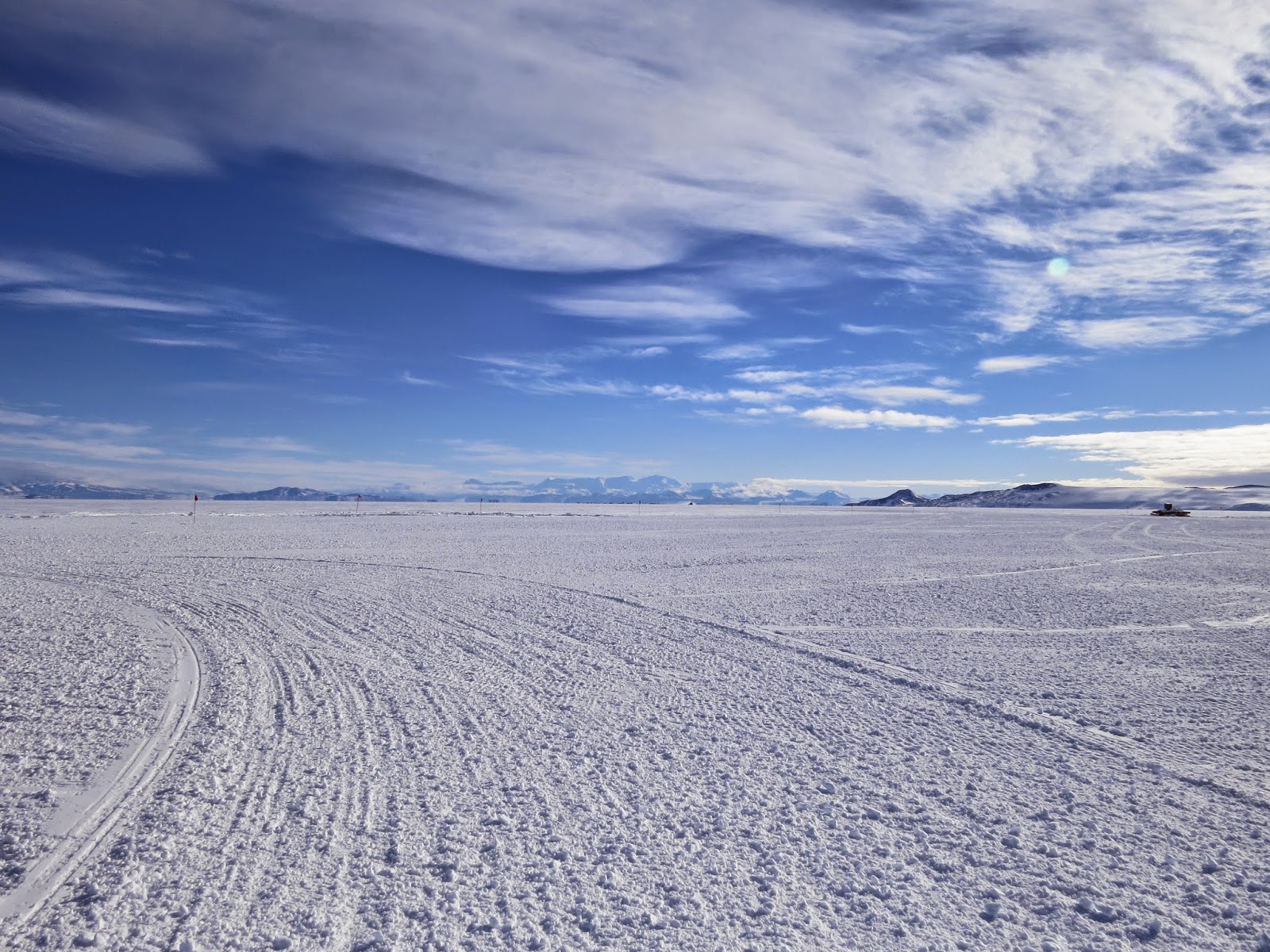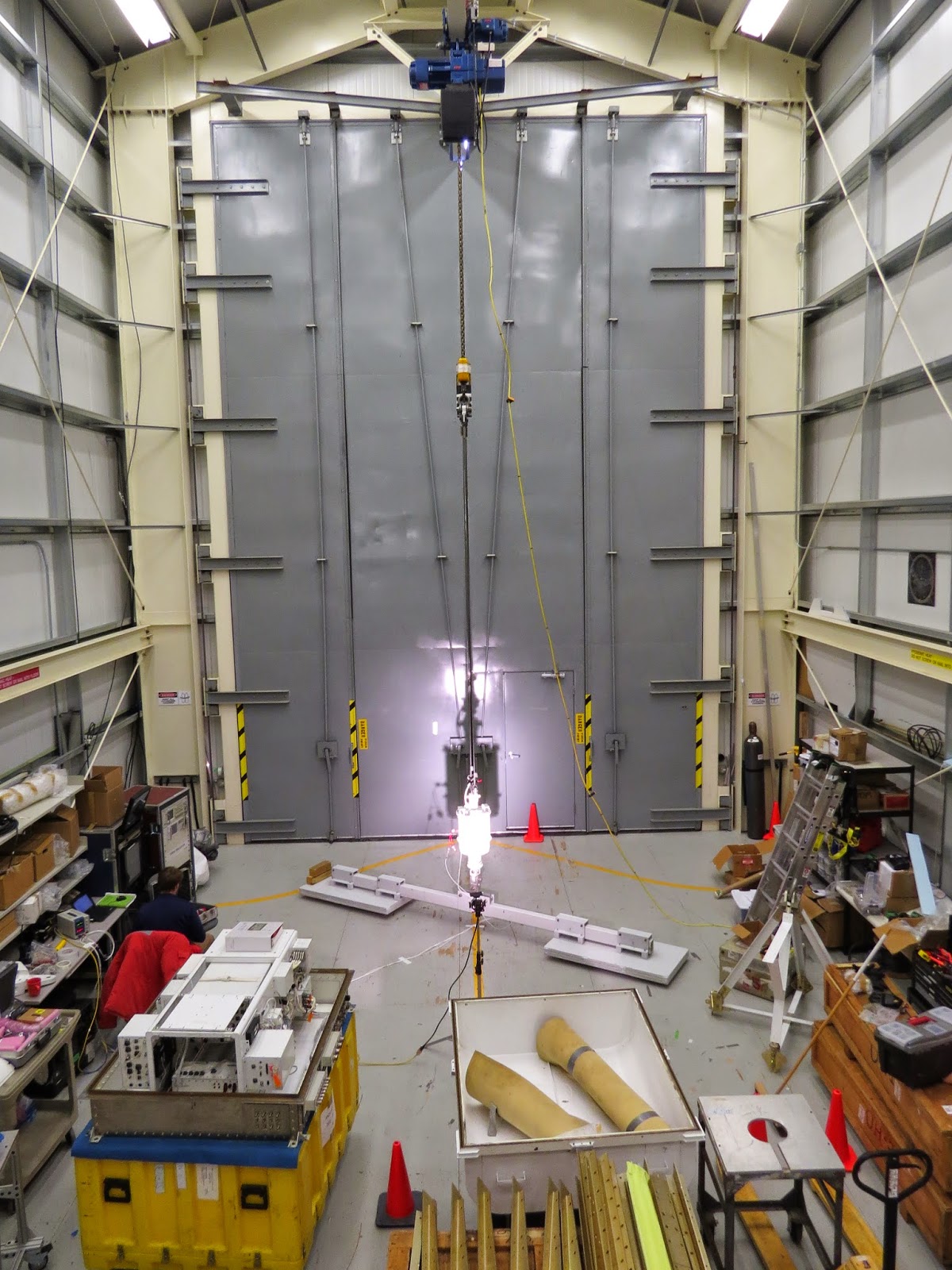Things have picked up at work, most of our cargo has showed up. However, we are sharing our hangar space for the time being to allow other groups to get things done while their hangar is being constructed.
Here is the part of the view from the Crary Lab library. The Crary Lab houses offices and lab facilities for much of the research on this side of the continent. If you look carefully below the sunlit hill in the middle of the photo on the horizon, you may notice some darkish spots. Those spots are the buildings at Pegasus Airfield, which is the ice runway that I landed at.
This is a telephoto shot of Pegasus Airfield.
Here you can see some more tanks.
This is a skull from a crabeater seal that was tracked since birth. I personally find the seal research the most interesting and so there are many interesting facts about seals. One of the facts that I like is that crabeater and Weddel seals keep their breathing holes in the ice open in the winter by gnawing on the ice. This results in a lot of wear to their teeth and therefore many adult seals die either from starvation due to worn down teeth or drowning as they can't keep their ice holes open. The main driving force behind this behavior is to keep them away from their main predators, orcas and leopard seals, as well as to allow them to forage in other areas. Leopard seals and orcas need to stay near the ice edge, but Weddell and crabeater seals can travel dozens of miles under the ice by finding tiny holes and cracks to breath out of.
Another interesting tidbit is that the Weddell seals that are around where I am at are pupping at this time of year. The mothers will nurse their pup for ~5 weeks, the pup will grow from about pounds to about 300 pounds in that time, and the mother will drop from about a 1,000 pounds to five or six hundred. She is fasting this entire time, partially due to the fact that she probably ate all the food in the area before giving birth. What is pretty amazing is the mass conversion ratio though. For every two pounds the mother loses, the pup gains a pound, which is incredibly efficient.
Most of the research in the area on the seals has to do with monitoring the population. They have tagged over 200,000 seals in the last 40 years including one 32 year old female that is currently the oldest known Weddell seal and who also happens to have had 22 pups. The research also looks at movements of seals year to year in the area as well as weight monitoring. They can measure the weight of the pups at a two days by putting pup in a bag and weighing it. The lack of land predators has helped make the mothers less protective but some still are. The researches use the pups to get the mothers onto scales to get their weights.
Most of the research in the area on the seals has to do with monitoring the population. They have tagged over 200,000 seals in the last 40 years including one 32 year old female that is currently the oldest known Weddell seal and who also happens to have had 22 pups. The research also looks at movements of seals year to year in the area as well as weight monitoring. They can measure the weight of the pups at a two days by putting pup in a bag and weighing it. The lack of land predators has helped make the mothers less protective but some still are. The researches use the pups to get the mothers onto scales to get their weights.
Here you can see the size comparison of a skua and an Adele penguin. The first skua made it to town earlier this week, but I haven't seen any yet. They made it south before the first winterovers made it north though. The first flight into South Pole was supposed to be on the 1st of November, but they didn't even attempt until yesterday and they couldn't land due to fog at the South Pole.
This a shot looking out across the sea ice onto some glacier.

This is the view from the LDB looking back towards Hut peninsula. You may recognize Ob Hill in the photo or maybe the wind turbines. McMurdo is on the other side of those hills.
We frequently take the KRESS to and from work. It is a huge vehicle, 98 feet long. The tractor cost
$750,000, the trailer with the cabin for the people cost $1,000,000. They had to move telephone poles and blast away part of the hillside in town so it could maneuver and it still can't make it to the main shuttle strop. There is another bus, Ivan that is only like 60 feet long and much more maneuverable and only takes 11 fewer people but the money the NSF had available to purchase another vehicle could only be used with an American company and Ivan is made by a foreign company. I believe many people feel that it would have made more sense to buy more Ivans or similar vehicles than once KRESS. They also have a cargo version which doesn't have the two passenger cabs. I think the preferred design would have been a four wheeled vehicle with a mid mounted engine for better weight distribution and traction as the KRESS has had some issues already getting good traction. The cab in the middle is called the DV, or distinguished visitor cab, by at least me. It is nice because the seats are arranged facing eachother so you can more easily have a conversation. It would probably also be ejected should the KRESS jackknife or roll down the hill.
Here is an action shot of the KRESS coming to pick us up, you may notice the Boss in the snow on the side.
Here is the interior, not the greates shot. The windows are two high up the side to see out of when you seated. and the heater doesn't currently work.
They had to install these feet guards as people would put their feet one what seemed like a good footrest, but the seats are on springs so it made for a very nasty pinch point.

I took this photo because a C-17 was flying out, you can see it in the upper left middle of the photo. (I don't know if that makes any sense). Apparently they will be trying to fly C-17's into McMurdo throughout the winter. There is a U.S. airbase in Australia that rotates a C-17 back to Washington state every six weeks. The Air Force agreed that the NSF would only need to pay to fly it to and from Antarctica. This would allow the NSF to resupply McMurdo year round and change personnel. It makes the cargo situation easier as the deadlines can almost go away. The NSF also hopes to make major renovations to McMurdo in the next few years as they could fly in carpenters, then electricians and plumbers, and then finish trades rather than having them all at McMurdo all winter waiting on eachother. They tried doing a night vision landing this past winter and were successful.


Here is a photo from inside our hangar from a few days ago.
The weather was real calm at LDB yesterday. On calm days you often get neat mirages which you may be able to see along the horizon here.
This device is a sun rotator. It is used to rotate payload as they are hanging. Some payloads want certain sides to face the sun or be pointed away from it, others, such as the payload used to test the Mars' parachutes want to be pointed a certain direction. The red caps cover sun sensors which are used to detection the location of the sun in relation to the rotator and can the be used point the gondola. We will not be using one, but another group will and CSBF needed a hook in a climate controlled environment to test it for flight so they used ours as we can get by without it for the time being.
These metal plates weigh in at 4,000 pounds and represent the gondola.
Here you can see a light representing the sun shining on the rotator.
This is the payload building called a weatherport that they are currently assembling for the third payload. It should be done next week. It will be heated, but can get quite noisy in the wind.





















No comments:
Post a Comment